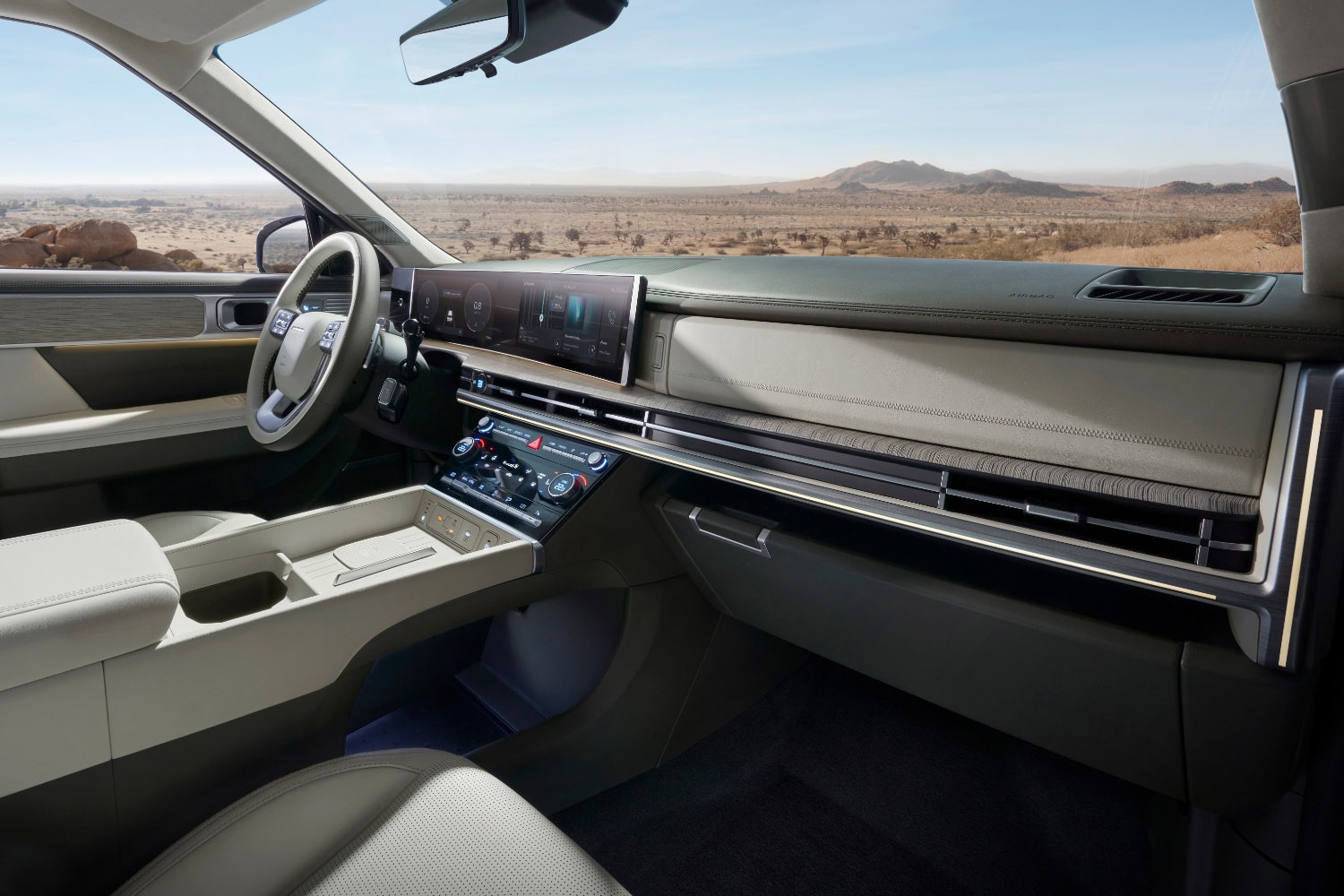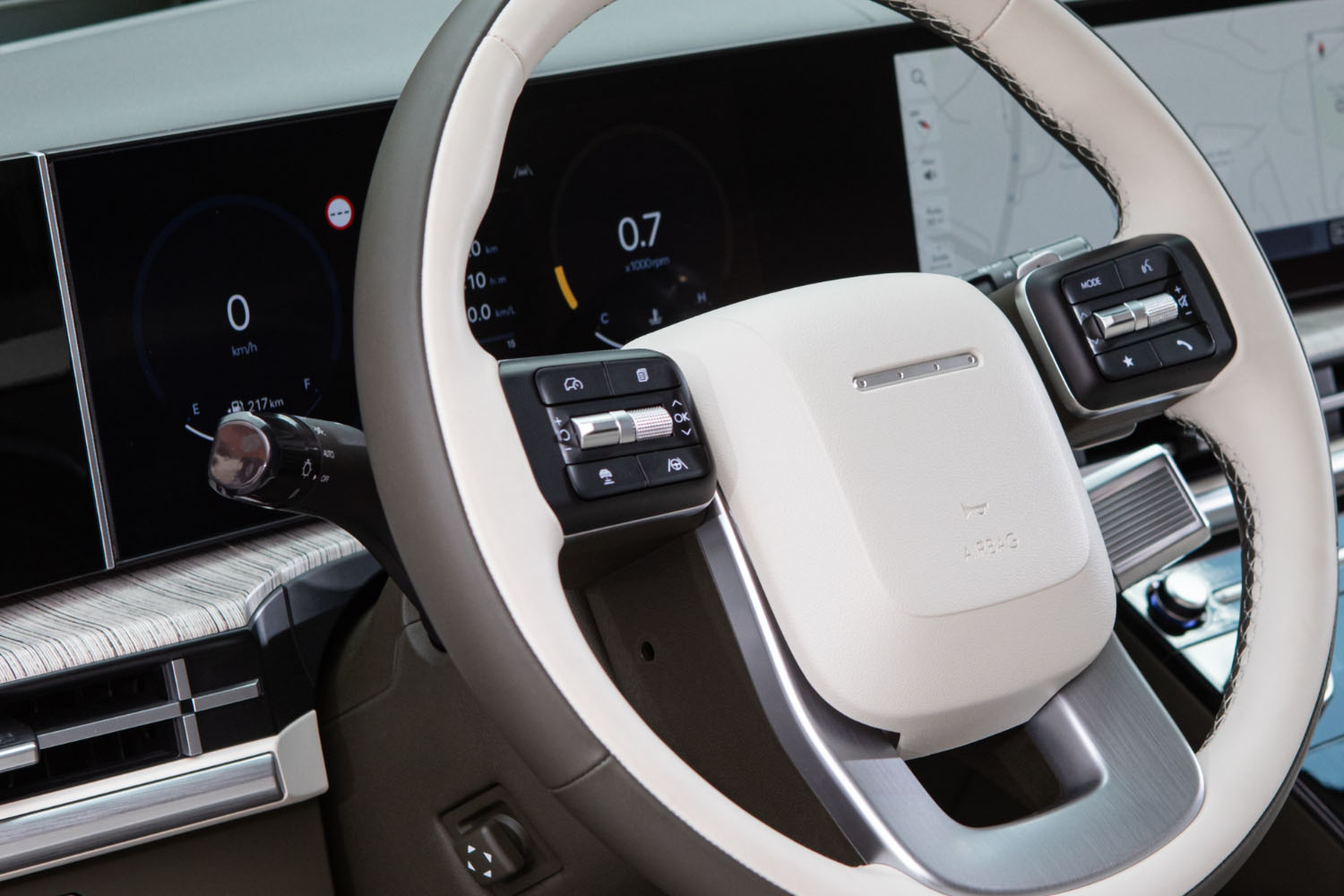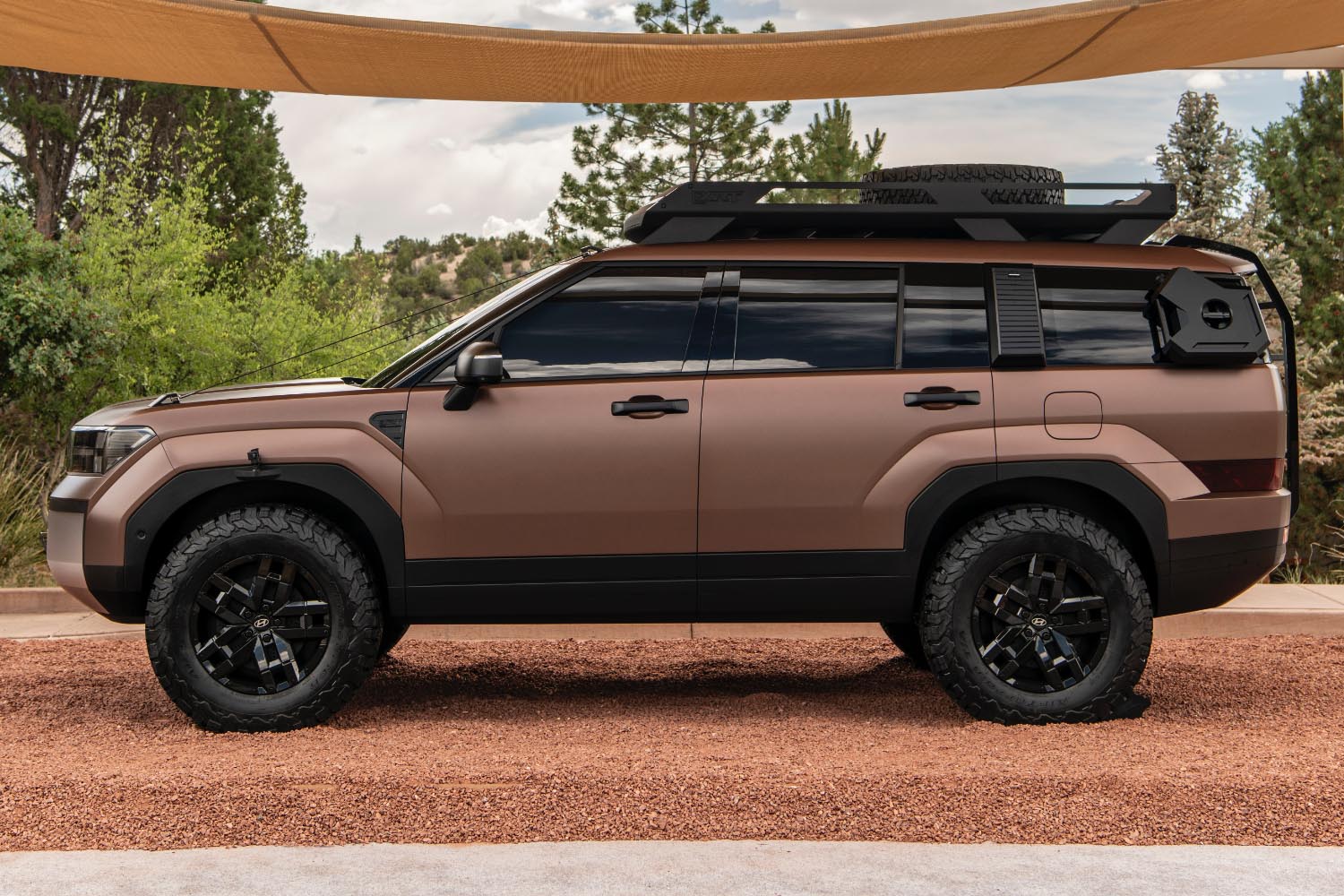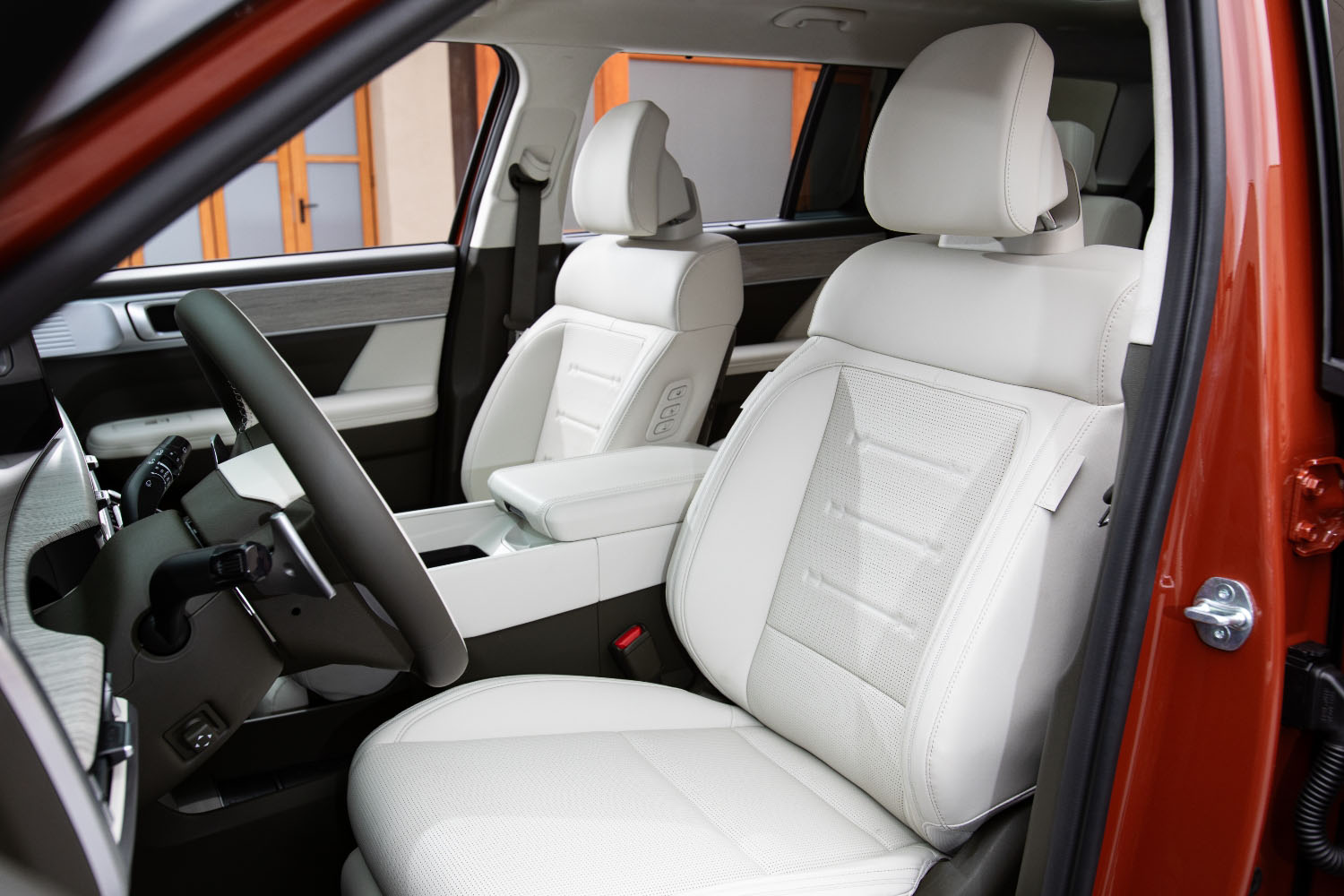2024 Hyundai Santa Fe Reveal: What's New, Photos, Specs, and More
The box that rocks — take two.
 Hyundai
Hyundai
Hyundai sells two midsize SUVs in the U.S. market. The Santa Fe is the smaller and more affordable one, equipped with two rows of seats and a five-passenger capacity. The Palisade is the larger and more expensive one, offering enough room for eight people in three rows of seats.
Given the broad and diverse midsize SUV market, this two-pronged approach allows Hyundai to appeal to more people while giving Santa Fe customers access to hybrid and plug-in hybrid powertrain options.
Now the automaker has revealed a redesigned 2024 Hyundai Santa Fe. It grows in size, adds a third-row of seats, and adopts an entirely different design language. But it remains smaller than the Palisade and, presumably, less expensive. Hyundai says the 2024 Santa Fe will go on sale in the U.S. market early next year, and official prices will be available closer to that date.
 Hyundai
Hyundai
2024 Hyundai Santa Fe Styling
Two decades ago, the Scion xB went on sale, and I called it "the box that rocks." It wasn't pretty but, in my opinion, it offered more functionality than any other small car in the U.S. The redesigned 2024 Hyundai Santa Fe reminds me of that xB, from its blunt nose to its upright rear. Even the grille, headlights, and front bumper recall the Scion, but in a modern manner.
Viewed from the side, the 2024 Santa Fe blends Jeep and Land Rover cues, while around the back, H-shaped horizontal taillights mounted directly above the bumper remind me of a Volkswagen 412 station wagon. So while the new Santa Fe's styling represents a radical departure from the current model, the design breaks no new ground.
To give you an idea of how large the new Santa Fe is, I converted the SUV's metric measurements and compared them with the current 2023 Hyundai Santa Fe and 2023 Palisade models:
- Wheelbase: 1.9 inches longer than a Santa Fe but 3.4 inches shorter than a Palisade
- Length: 1.8 inches longer than a Santa Fe but 5.9 inches shorter than a Palisade
- Width: Same as the Santa Fe but 3.0 inches narrower than a Palisade
- Height: 0.8 inches taller than a Santa Fe (Calligraphy trim) but 0.8 inches shorter than a Palisade
The new 2024 Santa Fe remains smaller than the Palisade, but not by much.
 Hyundai
Hyundai
2024 Hyundai Santa Fe Interior
Similar to how the new 2024 Santa Fe grows in exterior size, it also gains interior room, the boxy design facilitating the added space for more passengers and cargo. Unfortunately, as of this writing, Hyundai has not announced complete specifications. But, by comparing the redesigned Santa Fe to the existing 2023 model and the 2023 Palisade, you can see how the SUV has grown yet remains smaller than its larger sibling.
When it comes to legroom, these are the measurements:
- Front-seat legroom: 0.2 inches more than a Santa Fe but 2.7 inches less than a Palisade
- Second-row legroom: 0.6 inches more than a Santa Fe but 0.1 inches less than a Palisade
- Third-row legroom: The U.S.-market 2023 Santa Fe doesn't have a third-row seat. Compared to the Palisade, the 2024 Santa Fe offers 1.4 inches less third-row legroom
Hyundai reports the new 2024 Santa Fe offers "class-leading cargo capacity" but offers just one undefined measurement to prove that assertion: 25.6 cu-ft of cargo space. Since the outgoing 2023 Santa Fe supplies 36.4 cu-ft of cargo room behind its second-row seat, the smaller figure likely refers to the area behind the new third-row seat.
The 2024 Santa Fe's interior design blends flat planes and sharp angles for a contemporary and upscale appearance. Digital instrumentation and a touchscreen infotainment system reside under a single piece of curved glass called the "panoramic curved display," and Hyundai claims it uses eco-friendly materials throughout. The steering-wheel design wouldn't look out of place in a Land Rover model, and the transmission's gear selector is a stalk mounted on the right side of the steering column.
Hyundai will offer front "relaxation seats" with a leg rest, similar to what you'll find in the automaker's https://www.capitalone.com/cars/vehicle-overview/2023/Hyundai/IONIQ_5 and Ioniq 6 electric vehicles. Heated and ventilated front seats are available, as is a heated steering wheel. In addition, the company says it designed the center console for easy use by both front- and rear-seat occupants. Dual glove compartments add to the available storage space.
Hyundai says the 2024 Santa Fe's interior will come in five colors, but they might not all be offered in the U.S. market.
 Hyundai
Hyundai
2024 Hyundai Santa Fe Technology
Details regarding the 2024 Hyundai Santa Fe's technology are thin, but the company has confirmed that the SUV will offer a digital instrumentation panel and a 12.3-inch touchscreen infotainment system. The two screens live side by side under a single panoramic curved display, and Hyundai keeps the tech current through over-the-air updates. The new Santa Fe also has a 6.6-inch touchscreen governing the climate controls.
Based on images of the 2024 Santa Fe, the infotainment system likely offers Apple CarPlay and Android Auto connectivity, a navigation system, a Bose premium sound system, and Hyundai's Sounds of Nature feature. Choose that, and you can play different ambient soundtracks through the SUV's speakers, such as the sounds of a forest, the beach, rain falling, and so forth.
In addition, the Santa Fe offers two wireless smartphone charging pads on the center console, a UV-C sterilization tray, a digital rearview mirror, and digital-key technology that transforms your smartphone into the vehicle's key.
 Hyundai
Hyundai
2024 Hyundai Santa Fe Safety
The new 2024 Santa Fe offers a long list of safety features, but as of this writing, Hyundai still needs to define what is standard and what is optional.
Based on how the automaker has packaged its advanced driving-assistance systems in the past, you can probably expect these safety features to be standard on the new Santa Fe:
- Forward-collision warning
- Automatic emergency braking
- Lane-departure warning
- Lane-keeping assist
- Blind-spot monitoring
- Rear cross-traffic alert
- Driver-attention warning
- Rear-occupant alert
- Safe-exit assist
In addition to these features, Hyundai says, its new Santa Fe will offer a navigation-based adaptive cruise control system that can automatically reduce vehicle speed for upcoming curves, an Intelligent Speed Limit Assist feature that automatically slows the SUV when speed limits change, a surround-view camera system, and front and rear parking sensors.
Remote Smart Parking Assist (RSPA) is also available on the new Santa Fe, but Hyundai doesn't define which version of the technology the SUV will have. Some models with RSPA can autonomously park themselves in parallel and perpendicular spaces, while others can simply drive straight forward and backward, such as into a garage. In either case, you can operate the system while standing outside the vehicle.
Highway Driving Assist (HDA) is also available on the 2024 Hyundai Santa Fe. It pairs the adaptive cruise control system with a lane-centering assist feature, providing a semi-autonomous driving-assistance system. The Santa Fe has a second-generation version of HDA, which includes lane-change assist.
 Hyundai
Hyundai
2024 Hyundai Santa Fe Technical Specifications
The 2024 Santa Fe will be available in the U.S. market with two powertrains. One is a hybrid drivetrain with a turbocharged 1.6-liter four-cylinder engine and a six-speed automatic transmission. This powertrain carries over from the outgoing Santa Fe Hybrid, making 178 horsepower and 195 lb-ft of torque. Based on overall industry trends, this will likely be the standard powertrain in the 2024 Santa Fe. Hyundai says it will accelerate the SUV to 60 mph in a leisurely 9.5 seconds.
The other powertrain is a turbocharged 2.5-liter four-cylinder engine married to an eight-speed dual-clutch automatic transmission. In the outgoing 2023 Santa Fe, this engine made 281 horsepower and 311 lb-ft of torque, which aligns with the metric figures Hyundai announced for the 2024 Santa Fe. Hyundai expects this powertrain to accelerate the SUV to 60 mph in about 8.0 seconds.
As of this writing, Hyundai does not plan to offer a plug-in hybrid electric (PHEV) version of the new Santa Fe in the North American market. However, since the SUV will be available in PHEV form in Europe, this strategy could change if there is demand for it.
Additionally, Hyundai showed off a Santa Fe XRT concept vehicle with a raised suspension, all-terrain tires, and overlanding gear bolted to the SUV's various surfaces. Expecting an eventual XRT version with some added off-roading capability is reasonable.
 Hyundai
Hyundai
2024 Hyundai Santa Fe Pricing
Hyundai at the time of this writing hasn't released prices for the 2024 Santa Fe. However, based on the larger Palisade model's price range, I'd guess the new Santa Fe will start in the mid-$30,000s and rise into the high $40,000s.
When it goes on sale in early 2024, the new Santa Fe will face few direct rivals. The first reason is the third-row seat, typically missing from smaller midsize SUVs. In this slice of the segment, few other vehicles offer one.
The second reason is that the segment in which the Santa Fe will compete is shrinking. For example, Ford is canceling the Edge, and the Nissan Murano is likely on the way out.
That means the new Hyundai Santa Fe will compete against two-row and smaller three-row midsize crossover SUVs. In addition to the Kia Sorento, the list includes the Chevrolet Blazer, Honda Passport, Jeep Grand Cherokee, Mazda CX-90, Nissan Pathfinder, Subaru Outback, Toyota Highlander, and Volkswagen Atlas Cross Sport.
Written by humans.
Edited by humans.
 Christian Wardlaw
Christian WardlawChris says his first word was "car." For as long as he can remember, he's been obsessed with them. The design. The engineering. The performance. And the purpose. He is a car enthusiast who loves to drive, but is most passionate about the cars, trucks, and SUVs that people actually buy. He began his career as the editor-in-chief of Edmunds.com in the 1990s, and for more than 30 years has created automotive content for CarGurus, J.D. Power, Kelley Blue Book, the New York Daily News, and others. Chris owns Speedy Daddy Media, has been contributing to Capital One Auto Navigator since 2019, and lives in California with his wife, kids, dog, and 2004 Mazdaspeed Miata.
Related articles
View more related articles